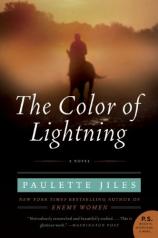Reading Group Guide
Discussion Questions
The Color of Lightning

1. In Chapter One, Mary shares with Britt her excitement to educate the children as the schoolteacher at Elm Creek. She says she is eager to teach them to recite bible stories (“For instance, how the people were freed from Babylon in Isaiah,”) and also stories of the children’s history. “She told the children stories of who they were,” Jiles writes, “That their great-grandfather had been brought from Africa, from a place called Benin, and that he was the son of a great king there…” Why is it important that these stories are passed on to the children as part of their elementary schooling? Why do you think Jiles opens the book with this?
2. How does paper and writing figure into the story? What does it mean to different characters? A few ideas to consider are Britt’s freedom papers, the children’s writing lessons, and Dr. Reed’s cough that sounded “like the burning of paper,” (pg. 34).
3. When the Comanche and Kiowa raid Elm Creek, Jiles doesn’t spare the reader gruesome details. Why do you think Jiles chooses to be explicit in her descriptions of the attacks, both in this scene, and in others throughout the book?
4. How does author use details of the environment in anchoring a scene? Compare Samuel and Lewis Henry Morgan walking through Philadelphia to Britt riding through the plains to the Red River.
5.We first meet Samuel Hammond in Chapter Three, a chapter that opens with the line, “the men who decided the fate of the Red Indians lived in the east, under roofs of slate and shingle.” Much is addressed in this single sentence; why do you think this is the way that the men of the Society of Friends Indian Committee are introduced?
6. What is a 'direct scene' and what is narrative summary? What are the effects of these techniques? Is the opening scene direct, or narrative summary? Find other examples.
7. In the book, we read that Lewis Henry Morgan spent fifteen years researching Indian tribes to write a report for the Smithsonian entitled Systems of Consanguinity and Affinity of the Human Family. Like many of the characters in this book, Morgan actually lived; he was an anthropologist who published this work in 1871. It was the first major study of relationship systems within Indian tribes, and Morgan demonstrated the centrality of “kinship” relations across these many tribes. Kinship, it was revealed, was an important key for understanding cultures. Why do you think this paper is noted in the book? What does kinship have to do with the story?
8. Furthermore, in their conversation on page 26, Samuel Johnson cannot recall the complete title of Morgan’s paper; why do you think Jiles makes a point of noting how difficult the title is to say?
9. What are the symbolic functions of mirrors? Find three examples. How does each 'reflect' a finding of the self?
10. When Dr. Reed is discussing plans for the Society, he tells of the Shawnee wars, the murder of Moravian Indians, and the small-pox infected blankets. He ends by asking, “What treaty have we not broken with these people?” What does this statement say about peacemaking? Do you think there is usefulness to a treaty?
11. A ship-owner states on page 32, “So much violence has been used against the red man. The Texans will be coming home from war, inured, accustomed to scenes of slaughter and violence we still have trouble comprehending. They have driven the red man from his own hunting grounds before the war, and they will continue to do so after it.” What does being “accustomed” to slaughter do to the relationships between parties in the book? What views are presented about using violence as a means to making peace? When is it successful, and when is it not?
12. Britt Johnson was an actual man whose story is documented to be true, and Jiles wrote The Color of Lightning based on her research of his life and surrounding events. What was your understanding of the relations between people in the US following the Civil War? Did it change after reading this? If so, in what ways?
The Color of Lightning
- Publication Date: June 15, 2010
- Genres: Fiction, Historical Fiction
- Paperback: 384 pages
- Publisher: Harper Perennial
- ISBN-10: 0061690457
- ISBN-13: 9780061690457








